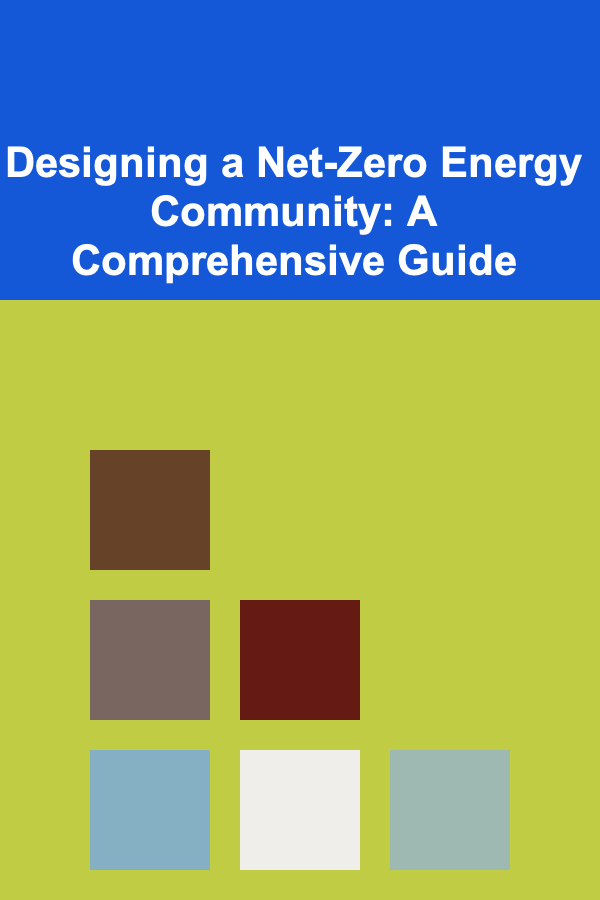
Designing a Net-Zero Energy Community: A Comprehensive Guide
ebook include PDF & Audio bundle (Micro Guide)
$12.99$11.99
Limited Time Offer! Order within the next:

The concept of a net-zero energy (NZE) community represents a paradigm shift in how we design, build, and operate human settlements. It envisions a future where communities generate as much energy as they consume, thereby minimizing their environmental impact and fostering a more sustainable way of life. Achieving this ambitious goal requires a holistic and integrated approach, encompassing everything from urban planning and architectural design to energy generation, storage, and distribution. This article provides a comprehensive guide to designing a net-zero energy community, exploring the key considerations, strategies, and technologies necessary for success.
I. Understanding Net-Zero Energy Communities
Before delving into the design process, it is crucial to understand the fundamental principles and definitions associated with net-zero energy communities.
A. Defining Net-Zero Energy
Net-zero energy, in its simplest form, means that the total amount of energy used by a building or community on an annual basis is roughly equal to the amount of renewable energy created on-site or nearby. It's critical to specify the boundaries and the accounting method. Is it site energy, source energy, or cost-based? Each method offers different perspectives and complexities.
- Site Energy: This is the energy consumed and produced at the building or community site, measured at the point of use. It is the most common and straightforward definition.
- Source Energy: This accounts for all energy required to deliver energy to the site, including losses during generation, transmission, and distribution. It provides a more comprehensive picture of the energy footprint.
- Cost-Based: This focuses on balancing the cost of energy consumed with the revenue generated from renewable energy production. This is influenced by utility pricing structures and incentives.
The chosen definition impacts the design and technology selection. Source energy targets, while more complex, promote greater energy efficiency and reduced reliance on fossil fuels, even when renewable energy is abundant. Cost-based targets are often driven by financial considerations and can incentivize on-site generation, even if the overall energy impact is less significant.
B. Beyond Energy: A Holistic Approach
While energy is the primary focus, a truly sustainable community considers a broader range of factors: resource consumption, waste management, transportation, water usage, and social equity. Integrating these considerations is essential for creating a resilient and thriving community.
- Water Conservation: Efficient water use reduces the energy required for water treatment and distribution. Rainwater harvesting, greywater recycling, and drought-tolerant landscaping are essential.
- Waste Management: Reducing waste through composting, recycling, and material reuse minimizes the energy needed for waste disposal and extraction of new resources.
- Sustainable Transportation: Prioritizing walking, cycling, and public transportation reduces reliance on private vehicles and lowers transportation-related energy consumption. Electric vehicle (EV) infrastructure should also be incorporated.
- Social Equity: Ensuring that the benefits of NZE communities are accessible to all residents, regardless of income or background, is crucial for social sustainability. This includes affordable housing options, access to green spaces, and opportunities for community engagement.
C. Key Characteristics of NZE Communities
NZE communities share several key characteristics:
- High Energy Efficiency: Buildings are designed and constructed to minimize energy demand through passive design strategies, high-performance building envelopes, and efficient appliances.
- Renewable Energy Generation: On-site or nearby renewable energy sources, such as solar photovoltaic (PV) systems, wind turbines, geothermal systems, and biomass energy, generate the energy needed to offset consumption.
- Smart Grid Integration: Advanced energy management systems, smart meters, and energy storage technologies enable efficient distribution and utilization of renewable energy.
- Community Engagement: Residents are actively involved in energy conservation efforts and participate in community-based renewable energy projects.
- Data Monitoring and Analysis: Continuous monitoring of energy consumption and production provides valuable data for optimizing performance and identifying areas for improvement.
II. The Design Process: A Step-by-Step Guide
Designing a net-zero energy community is a complex and iterative process that requires careful planning and collaboration among various stakeholders. The following steps outline a comprehensive approach:
A. Phase 1: Visioning and Goal Setting
The initial phase involves defining the vision for the community and setting specific, measurable, achievable, relevant, and time-bound (SMART) goals. This should involve community members, developers, local government, and other relevant stakeholders.
- Community Engagement: Conduct surveys, workshops, and public forums to gather input from residents and identify their priorities and concerns.
- Define Vision Statement: Articulate a clear and compelling vision for the community that reflects the shared values and aspirations of its members.
- Set SMART Goals: Establish specific targets for energy consumption, renewable energy production, water conservation, waste reduction, and other key performance indicators. Example: Achieve net-zero energy by [Year], reduce water consumption by [Percentage] by [Year].
- Establish Key Performance Indicators (KPIs): Select metrics to track progress toward achieving the goals. KPIs should be measurable and regularly monitored.
- Develop a Conceptual Master Plan: Create a preliminary plan that outlines the overall layout of the community, including land use, building types, transportation networks, and open spaces.
B. Phase 2: Site Analysis and Assessment
A thorough site analysis is crucial for identifying opportunities and constraints that can influence the design of the community. This includes assessing solar potential, wind resources, geothermal potential, water availability, and existing infrastructure.
- Solar Resource Assessment: Analyze solar irradiance data to determine the optimal placement and orientation of solar PV systems. Consider shading from existing buildings and vegetation.
- Wind Resource Assessment: Evaluate wind speeds and patterns to determine the feasibility of wind turbines. Consider noise impacts and visual aesthetics.
- Geothermal Potential Assessment: Assess the suitability of the site for geothermal heating and cooling systems. Conduct geological surveys and thermal conductivity tests.
- Water Resource Assessment: Evaluate water availability and quality. Identify opportunities for rainwater harvesting and greywater recycling.
- Existing Infrastructure Assessment: Assess the capacity of existing infrastructure (e.g., electricity grid, water and sewer lines, transportation networks) to support the community. Identify opportunities for upgrades and expansions.
- Environmental Impact Assessment: Evaluate the potential environmental impacts of the project, including impacts on air and water quality, biodiversity, and greenhouse gas emissions.
C. Phase 3: Integrated Design and Planning
This phase involves developing a detailed design for the community, integrating energy efficiency measures, renewable energy systems, and sustainable infrastructure. This phase emphasizes integrated design principles, meaning that all aspects of the design are considered simultaneously and optimized to achieve the overall goals of the project.
- Passive Design Strategies: Implement passive design strategies to minimize energy demand. This includes:
- Orientation and Building Form: Orient buildings to maximize solar gain in winter and minimize solar gain in summer. Design building forms to promote natural ventilation and daylighting.
- Insulation and Air Sealing: Use high levels of insulation and air sealing to reduce heat loss and gain.
- Window Design: Select high-performance windows with low U-values and high solar heat gain coefficients (SHGC) for passive solar heating. Use shading devices to reduce solar heat gain in summer.
- Natural Ventilation: Design buildings to promote natural ventilation and reduce the need for mechanical cooling.
- Daylighting: Maximize daylighting to reduce the need for artificial lighting. Use light shelves and skylights to distribute daylight deep into buildings.
- High-Performance Building Envelopes: Design building envelopes that minimize energy loss and gain. This includes:
- Advanced Framing Techniques: Use advanced framing techniques to reduce thermal bridging and improve insulation performance.
- Continuous Insulation: Install continuous insulation to minimize heat loss and gain through walls and roofs.
- Air Barrier Systems: Install air barrier systems to prevent air leakage and improve building performance.
- Efficient Appliances and Equipment: Specify energy-efficient appliances and equipment, such as ENERGY STAR-rated appliances, high-efficiency HVAC systems, and LED lighting.
- Renewable Energy Systems: Integrate renewable energy systems into the community design. This includes:
- Solar Photovoltaic (PV) Systems: Install solar PV systems on rooftops, parking structures, and other suitable locations to generate electricity.
- Solar Thermal Systems: Use solar thermal systems to heat water for domestic hot water and space heating.
- Wind Turbines: Install wind turbines to generate electricity in areas with suitable wind resources.
- Geothermal Systems: Use geothermal systems to heat and cool buildings.
- Biomass Energy Systems: Utilize biomass energy systems to generate heat and electricity from sustainable biomass sources.
- Smart Grid and Energy Storage: Implement a smart grid and energy storage technologies to optimize energy distribution and utilization. This includes:
- Smart Meters: Install smart meters to provide residents with real-time information about their energy consumption.
- Advanced Metering Infrastructure (AMI): Implement AMI to enable two-way communication between the utility and the community.
- Energy Storage Systems: Install energy storage systems, such as batteries, to store excess renewable energy and provide backup power.
- Demand Response Programs: Implement demand response programs to incentivize residents to reduce energy consumption during peak periods.
- Sustainable Transportation Planning: Design a transportation system that prioritizes walking, cycling, and public transportation. This includes:
- Compact, Mixed-Use Development: Design the community with compact, mixed-use development to reduce the need for driving.
- Pedestrian and Bicycle Infrastructure: Provide safe and convenient pedestrian and bicycle infrastructure, such as sidewalks, bike lanes, and trails.
- Public Transportation: Provide access to public transportation, such as buses, trains, and light rail.
- Electric Vehicle (EV) Charging Infrastructure: Install EV charging infrastructure to support the adoption of electric vehicles.
- Car Sharing Programs: Implement car sharing programs to reduce the need for individual car ownership.
- Water Conservation Strategies: Implement water conservation strategies to reduce water consumption. This includes:
- Water-Efficient Fixtures and Appliances: Specify water-efficient fixtures and appliances, such as low-flow toilets, showerheads, and faucets.
- Rainwater Harvesting: Implement rainwater harvesting systems to collect rainwater for irrigation and other non-potable uses.
- Greywater Recycling: Implement greywater recycling systems to reuse greywater (water from showers, sinks, and washing machines) for irrigation and toilet flushing.
- Drought-Tolerant Landscaping: Use drought-tolerant landscaping to reduce the need for irrigation.
- Waste Management Strategies: Implement waste management strategies to reduce waste generation and promote recycling and composting. This includes:
- Composting Programs: Implement composting programs to collect and compost food scraps and yard waste.
- Recycling Programs: Implement comprehensive recycling programs to collect and recycle paper, plastic, glass, and metal.
- Construction and Demolition Waste Management: Develop a plan for managing construction and demolition waste to minimize waste sent to landfills.
D. Phase 4: Construction and Commissioning
During the construction phase, it is crucial to ensure that the design is implemented correctly and that all systems are properly installed and commissioned. This requires close collaboration between the design team, contractors, and building operators.
- Quality Control: Implement a rigorous quality control program to ensure that all construction work meets the required standards.
- Construction Waste Management: Manage construction waste effectively to minimize waste sent to landfills.
- Commissioning: Commission all building systems to ensure that they are operating efficiently and effectively. This includes testing and adjusting HVAC systems, lighting controls, and renewable energy systems.
- Building Operator Training: Provide building operators with training on how to operate and maintain the building systems.
E. Phase 5: Monitoring and Evaluation
After the community is occupied, it is essential to monitor energy consumption and production to ensure that the community is achieving its net-zero energy goals. This data can be used to identify areas for improvement and optimize the performance of the community.
- Data Collection: Collect data on energy consumption, renewable energy production, water consumption, and waste generation.
- Performance Analysis: Analyze the data to assess the performance of the community and identify areas for improvement.
- Reporting: Report the performance of the community to stakeholders, including residents, developers, and local government.
- Continuous Improvement: Use the data to continuously improve the performance of the community and achieve its net-zero energy goals.
III. Technologies and Strategies for Achieving Net-Zero Energy
A wide range of technologies and strategies can be employed to achieve net-zero energy in a community. The specific technologies and strategies that are most appropriate will depend on the climate, site conditions, and community goals.
A. Energy Efficiency Technologies
- High-Performance Windows and Doors: Windows and doors with low U-values and high SHGC can significantly reduce heat loss and gain.
- High Levels of Insulation: Insulation reduces heat transfer through walls, roofs, and floors.
- Air Sealing: Air sealing prevents air leakage, which can significantly reduce energy loss.
- Efficient HVAC Systems: High-efficiency HVAC systems, such as heat pumps, can significantly reduce energy consumption for heating and cooling.
- Efficient Lighting: LED lighting is much more efficient than traditional incandescent lighting.
- Energy Management Systems: Energy management systems can automatically control lighting, HVAC, and other building systems to optimize energy efficiency.
B. Renewable Energy Technologies
- Solar Photovoltaic (PV) Systems: Solar PV systems convert sunlight into electricity.
- Solar Thermal Systems: Solar thermal systems use sunlight to heat water for domestic hot water and space heating.
- Wind Turbines: Wind turbines convert wind energy into electricity.
- Geothermal Systems: Geothermal systems use the earth's constant temperature to heat and cool buildings.
- Biomass Energy Systems: Biomass energy systems generate heat and electricity from sustainable biomass sources.
C. Energy Storage Technologies
- Batteries: Batteries store electricity for later use.
- Thermal Energy Storage: Thermal energy storage systems store heat or cold for later use.
- Pumped Hydro Storage: Pumped hydro storage systems store energy by pumping water uphill to a reservoir.
D. Smart Grid Technologies
- Smart Meters: Smart meters provide residents with real-time information about their energy consumption.
- Advanced Metering Infrastructure (AMI): AMI enables two-way communication between the utility and the community.
- Demand Response Programs: Demand response programs incentivize residents to reduce energy consumption during peak periods.
IV. Challenges and Opportunities
Designing and implementing a net-zero energy community presents both challenges and opportunities.
A. Challenges
- High Upfront Costs: NZE communities often require higher upfront investments in energy efficiency measures and renewable energy systems.
- Complexity: Designing and implementing an NZE community is a complex process that requires expertise in a variety of fields.
- Permitting and Regulatory Hurdles: Permitting and regulatory processes can be lengthy and complex.
- Public Acceptance: Gaining public acceptance for new technologies and approaches can be challenging.
- Grid Interconnection Issues: Interconnecting renewable energy systems to the grid can be challenging.
B. Opportunities
- Reduced Energy Costs: NZE communities can significantly reduce energy costs for residents.
- Reduced Environmental Impact: NZE communities have a significantly lower environmental impact than conventional communities.
- Increased Property Values: NZE homes and communities often have higher property values.
- Economic Development: NZE communities can attract businesses and create jobs in the renewable energy and energy efficiency sectors.
- Improved Quality of Life: NZE communities can provide a healthier and more comfortable living environment for residents.
V. Case Studies of Existing Net-Zero Energy Communities
Several net-zero energy communities have already been developed around the world, demonstrating the feasibility of this concept. Studying these case studies can provide valuable insights and lessons learned.
Examples of NZE communities include:
- Vauban, Freiburg, Germany: Vauban is a car-free neighborhood that prioritizes pedestrians and cyclists. It features energy-efficient homes, solar PV systems, and a combined heat and power (CHP) plant.
- Drake Landing Solar Community, Okotoks, Alberta, Canada: This community uses solar thermal collectors and seasonal thermal energy storage to provide 90% of its space heating needs.
- West Village, Davis, California, USA: West Village is a university-affiliated community that features energy-efficient homes, solar PV systems, and a smart grid.
Analyzing these and other case studies reveals common themes:
- Strong community support and participation are essential.
- Integrated design and planning are critical for success.
- Continuous monitoring and evaluation are needed to optimize performance.
VI. The Future of Net-Zero Energy Communities
Net-zero energy communities represent a significant step towards a more sustainable future. As technology advances and costs decline, NZE communities are becoming increasingly feasible and attractive.
Future trends in NZE community design include:
- Increased adoption of renewable energy technologies: Solar PV and wind energy costs are continuing to decline, making these technologies more accessible.
- Greater integration of energy storage: Energy storage technologies are becoming more affordable and efficient.
- Development of smart grid technologies: Smart grid technologies are enabling more efficient distribution and utilization of renewable energy.
- Focus on resilience and grid independence: Communities are increasingly seeking to become more resilient to grid outages and disruptions.
- Integration of electric vehicles and charging infrastructure: Electric vehicles are becoming more popular, and communities are providing charging infrastructure to support their adoption.
- Emphasis on community engagement and education: Educating residents about energy conservation and renewable energy is crucial for the success of NZE communities.
VII. Conclusion
Designing a net-zero energy community is a challenging but rewarding endeavor. By embracing a holistic and integrated approach, utilizing advanced technologies, and engaging the community, we can create sustainable and thriving settlements that minimize their environmental impact and enhance the quality of life for residents. The transition to net-zero energy communities is not just about energy; it is about creating a more sustainable, resilient, and equitable future for all.
The key to success lies in a comprehensive understanding of the principles of net-zero energy, a thorough assessment of site conditions, a commitment to integrated design and planning, and a willingness to embrace innovation. By learning from existing NZE communities and adapting best practices to local contexts, we can accelerate the transition to a more sustainable future powered by clean, renewable energy.

How to Set Up a Real Estate Investment Group
Read More
How to Use Pegboards for Creative Storage Solutions
Read More
How To Style Cargo Pants for Everyday Wear
Read More
How to Discover New Treatments for Autoimmune Liver Diseases
Read More
How to Bake Chiffon and Sponge Cakes
Read More
The Practical Step-by-Step Guide to Everyday Life
Read MoreOther Products

How to Set Up a Real Estate Investment Group
Read More
How to Use Pegboards for Creative Storage Solutions
Read More
How To Style Cargo Pants for Everyday Wear
Read More
How to Discover New Treatments for Autoimmune Liver Diseases
Read More
How to Bake Chiffon and Sponge Cakes
Read More